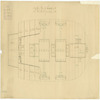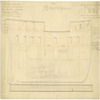Preparations
By February 1845 preparations were well underway to refit the Erebus and the Terror, in order to strengthen them for Arctic ice conditions. These upgrades included a doubling of the hull, the heavy wooden reinforcement of the bows to a thickness of eight feet, and installation of a special protective sheet iron, not to mention the addition of auxiliary steam engines and screw propellers for churning through ice more effectively. While the Admiralty predicted a one-year voyage, each of the ships was equipped with enough provisions to sustain their crews for three years in case of ice-induced delays. They also carried 200 tin canisters designed to hold paper records reporting the ships' latitude and longitude to aid search vessels in finding them in the event of distress.
Why did the British government send this expedition? The Admiralty's sailing orders to Franklin provided an extensive list of objectives, some of which related to the discovery of the Northwest Passage, while others were oriented to science and specifically to geomagnetic observations. Indeed, the question of the Admiralty's true motives and objectives might have had a bearing on the route and progress of the Expedition. If Franklin was focused primarily on attaining the Northwest Passage, he would likely have sought as direct a route to the Bering Strait as he could find. If, on the other hand, he was focusing on magnetic readings, might he not have been more inclined to sail south through Peel Sound toward the North Magnetic Pole? In other words, did the Magnetic Pole lead Franklin's party to become mired in the ice-congested waters of the Victoria Strait? See the section on the search for the North Magnetic Pole in the Ripples and Ice Jams section and decide for yourselves.
Was Sir John Franklin the right man for this job? Not everyone thought so at the time. Several senior officials privately expressed concern about Franklin's age (59 years old), his physical condition (portly), and his alleged intolerance of the cold. During the winter of 1844-45 Franklin had experienced a severe bout of influenza, which he acknowledged he was still suffering from even after the expedition departed in May 1845. Franklin did his best to counter these assertions and, in the end, Haddington gave the nod to the veteran Arctic explorer and experienced magnetic scientist. Placed in charge of recruitment and staffing, Commander James Fitzjames hired a mix of men with some prior experience on Arctic expeditions and many former shipmates with no Arctic experience. James Reid and Thomas Blanky, engaged as ice masters for the two ships, were polar veterans but only six of the expedition's 18 officers had prior Arctic experience. Overall, it was one of the least experienced expeditions ever sent by the Admiralty, in terms of polar service, to the Arctic. Do you think Fitzjames made the right choices?




